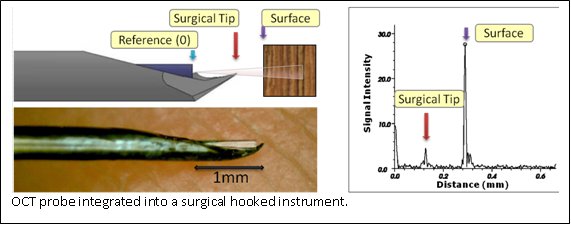Contact Us
CiiS Lab
Johns Hopkins University
112 Hackerman Hall
3400 N. Charles Street
Baltimore, MD 21218
Directions
Lab Director
Russell Taylor
127 Hackerman Hall
rht@jhu.edu
OCT provides very high resolution (micron scale) images of anatomical structures within the tissue. Within Ophthalmology, OCT systems typically perform imaging through microscope optics to provide 2D cross-sectional images (“B-mode”) of the retina. These systems are predominantly used for diagnosis, treatment planning, and in a few cases, for optical biopsy and image guided laser surgery. We are developing intra-ocular instruments that combine surgical function with OCT imaging capability in a very small form factor.
 Dr. Kang’s group has built a custom common path Fourier domain Optical Coherence Tomography (CP-OCT) designed specifically for interfacing with smart surgical instruments for vitreoretinal surgery. The system can be used for retinal tissue imaging and also as a depth range sensor. The CP-OCT works on the principle that coherent light interferes with itself after it is reflected and refracted. This interference encodes (in Fourier domain) the distances from the reference plane to the optically opaque layers of the imaged sample. The whole axial depth scan (A-Scan) can be collected in a single exposure and processed with Fast Fourier Transform.
Dr. Kang’s group has built a custom common path Fourier domain Optical Coherence Tomography (CP-OCT) designed specifically for interfacing with smart surgical instruments for vitreoretinal surgery. The system can be used for retinal tissue imaging and also as a depth range sensor. The CP-OCT works on the principle that coherent light interferes with itself after it is reflected and refracted. This interference encodes (in Fourier domain) the distances from the reference plane to the optically opaque layers of the imaged sample. The whole axial depth scan (A-Scan) can be collected in a single exposure and processed with Fast Fourier Transform.
 OCT imaging can be used as a range finder by extracting the distance from the probe’s reference to the first large peak in the A-Scan, which generally represents the surface of the sample. Resulting real-time range information is used as a feedback parameter in a virtual fixture framework for cooperative robot control. In the case of targeting, additional retinal tracking ability is required. This may be provided by video processing to extract tool position relative to the retina.
OCT imaging can be used as a range finder by extracting the distance from the probe’s reference to the first large peak in the A-Scan, which generally represents the surface of the sample. Resulting real-time range information is used as a feedback parameter in a virtual fixture framework for cooperative robot control. In the case of targeting, additional retinal tracking ability is required. This may be provided by video processing to extract tool position relative to the retina.
ML45iQB2oU0
FufTkqaws4c
We have built a robust OCT system and associated micro instruments. The device is compatible with our EyeSAW software framework allowing for rapid prototyping of “behaviors” combining the functionality of other EyeSAW devices. We have added audio sensory substitution to indicate the proximity of the instruments to the retina. Another method uses video overlays to present OCT images.
We are looking into building new OCT integrated instruments and more intelligent ways to present the data to the surgeons. Another research area is OCT image processing to detect structures such as blood vessels and membranes that can be used for robot assisted interventions.
| JHU Whiting School | JHU Hospital, Wilmer Eye Institute |
|---|---|
| Dr. Russell Taylor | Dr. James Handa |
| Dr. Greg Hager | Dr. Peter Gehlbach |
| Dr. Jin Kang | |
| Dr. Iulian Iordachita | |
| Marcin Balicki | |
| Xuan Liu | |
| Yi Yang |